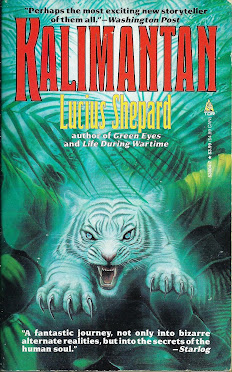Motel Bizarre
by Stephanie Crabe
Scapegoat Publishing, 2007
by Stephanie Crabe
Scapegoat Publishing, 2007
The PorPor Books Blog is devoted to covering sci-fi, fantasy, and horror paperbacks published during the interval from roughly 1968 to 1988, and I rarely deviate from reviewing and promoting media from that era. However, I occasionally make exceptions, when I feel an obligation to promote books that fall outside that range of time and topic.
So it is with 'Motel Bizarre', which probably is too contemporary, and too eccentric, to get coverage from sites like 'Glorious Trash' and 'Paperback Warrior'. And 'Motel Bizarre' is deserving of coverage, because I believe it has appeal to those paperback fanatics who are fans of sleaze and noir content (but then, who isn't a fan of sleaze and noir content ?!).
Anyways, 'Motel Bizarre' is a 10 1/2 x 8 1/4 inch landscape format trade paperback published in 2007 by Scapegoat Publishing, a short-lived, small press publisher founded by Chris X, aka Christopher Neu, aka Christopher Xavier Donovan, the owner of Reptilian Records, a record, comic, and memorabilia shop located on South Broadway Street in Baltimore's Fells Point neighborhood in the 1990s.
[ I used to be a regular patron of Reptilian, back in the day, and I could write a blog post alone on that store and the hipster scene in Baltimore in the early 1990s.......... ]
But on to 'Motel Bizarre', which features an introduction by Christopher Mealie, whose photos of dilapidated motels are sprinkled throughout the pages of the book. The introduction starts off with some interesting observations about the origin and heyday of the motel in American culture and commerce, but then Mealie inexplicably veers off into an adjective- and adverb-littered parody of hardboiled crime fiction, and becomes just another example of a hipster trying too hard to be hip............
The staged photographs, all taken in color and featuring friends and models of Ms. Crabe, appear to have been taken in genuine motel settings and depict all manner of patently sleazy acts that are in keeping with the theme of retro-influenced American noir, as inspired by David Lynch and John Waters.
There are elements of provocation, and also of humor, in the tableaus presented in 'Motel Bizarre'. The decor, lighting (no soft focus or flesh-toned makeup operating here, folks), and framing of the pictures gives them the authenticity necessary to shock (wink-wink) bourgeoisie sensibilities.
The few reviews of 'Motel Bizarre' that I have found online go overboard with quasi-academic jargon, and in that spirit I might declare that:
'........the Transgressive Iconography of Stephanie Crabe's pictorial narratives ushers us into a world that, however repugnant it may seem at first glance, is nonetheless as fully realized as any translational zeitgeist of postwar American popular culture.'
This is one book I'm going to prominently leave lying around my house when friends, family, vegans, recovering alcoholics, hipsters, and Womyn's Rights activists come to call.....................














































































